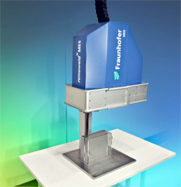 |
Date Announced: 23 May 2017
Modularly-designed remoweld MPNG-welding head. © Photo Fraunhofer IWS Dresden.
Confidence and reliability are key criteria for the potential introduction of innovative joining techniques. This is, in particular, also true for the modern maritime industry.
Scientists of the Fraunhofer IWS have developed a novel, low heat-input but highly efficient laser welding technology for joining processes of up to 50 mm thick parts made of seawater-resistant aluminum alloys.
A decisive advantage of this technology is the comparatively low laser power (< 4 kW) needed during the welding of thick metal sheets. The low laser power enables extraordinarily small weld seam widths and minimal component distortion.
The IWS laser multi-pass-narrow-gap welding technology (laser MPNG) has been successfully certificated by the classification society DNV GL and is thus now ready for potential industrial applications.
Shipbuilding
The MPNG technology helps to overcome current technological limits with respect to achievable welding depths, possible mechanical properties and seam quality. This is especially important for shipbuilding parts with up to 50 mm wall thicknesses made of naturally hard aluminum alloys. For the very first time it is possible to produce economically high-quality and low-distortion joints with high strength.
Industrial applications benefit from the very low investment costs with respect to laser sources (power ranges up to 4 kW) and in particular from up to 80% savings of the expensive welding fillers as well as from the minimization of time-consuming reworks.
The process development was closely linked with the definition of systems technological requirements, in order to control the multi-pass-narrow-gap welding process. The integration of sensors technology and camera equipment, which on the one hand, measures depth and width of the gap and, on the other hand, allows conclusions with respect to process, enables a closed process control.
The IWS technology offers a modular welding optics including a PLC-based control unit, separately developed.
The successful DNV GL certification proves the controllability of the laser MPNG technology and guarantees the agreed guidelines with respect to weld seam quality and mechanical joint properties for maritime applications.
The project was funded by the Federal Ministry of Education and Research under Project Number 13N13000. The responsibility for the publication’s content lies with the author.
E-mail: info@iws.fraunhofer.de
Web Site: www.iws.fraunhofer.de
| © 2025 SPIE Europe |
|